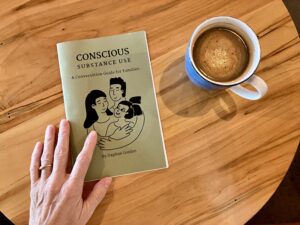ZINE #1: CONSCIOUS SUBSTANCE USE

Conscious Substance Use
A Conversation Guide for Families
Conscious Substance Use: A Conversation Guide for Families is a 20-page zine designed to help families discuss substance use thoughtfully. Whether you’re a parent, sibling, or an auntie who cares deeply about fostering healthy dialogue, this guide offers practical tools to approach the topic of substance use without fear.
My zine emphasizes that young people should wait until their brains are fully developed before using substances. However, did you know that kids’s brains aren’t fully developed until the age of 24? We can’t wait until then to start educating our kids. If we do, it will be too late. By the time their brains are fully developed, they’ll already have have left the nest.
In ZINE #1, Conscious Substance Use, I cover:
- Going beyond stereotypes to talk about why people use substances and what their potential harms are
- Initiating calm and connected dialogues, rather than lectures about substance use
- Communicating expectations that align with your family’s beliefs and experiences
- Helpful resources and prompts for continuing the conversation beyond the pages of this guide
Choose your edition
CONSCIOUS SUBSTANCE USE
PAPER EDITION – $12
- Hand-bound booklet made from high-quality paper
- Cardstock cover with a staple binding
- 22 pages, 5.5″ X 8.5″ format
- Delivered within 5-10 days (in US and Canada)
CONSCIOUS SUBSTANCE USE
DIGITAL EDITION – $8
- PDF format, can be printed or read on any device
- Feel free to print and share multiple copies
- 22 pages, 8.5″ x 11″ format
- Delivered to your inbox immediately
ZINE #2: MAKING SENSE OF SUBSTANCES

MAKING SENSE OF SUBSTANCES
AN A-Z GUIDE TO SUBSTANCES
Are you looking for a practical, straightforward resource to help your family understand the complex world of substance use?
Making Sense of Substances: An A-Z Guide for Families is a 30-page zine that provides clear, accessible descriptions of 20 common drugs. From alcohol to salvia, this guide breaks down what each substance is, what effects it has, and basic harm reduction tips to promote safer choices.
Having a print guide like this around the house is incredibly helpful—it’s always within reach for quick reference and doesn’t require scrolling through complicated online resources. Written in straightforward, accessible language, it’s easy for anyone to understand without being too clinical, technical, or overwhelming.
Perfect for parents, siblings, or anyone who wants to approach substance use with empathy and knowledge, this zine is designed to foster informed, judgment-free discussions. By equipping your family with facts and practical tools, Making Sense of Substances empowers young people to make safer, more thoughtful decisions about drugs.
In Zine #2, Making Sense of Substances, I cover:
- The basic facts on common drugs teens and young adults might encounter
- A useful template for understanding how to research drugs
- Harm reduction tips for each substance
- Helpful resources for deeper research if needed
Choose your edition
MAKING SENSE OF SUBSTANCES
PAPER EDITION – $12
- Hand-bound booklet made from high-quality paper
- Cardstock cover with a staple binding
- 22 pages, 5.5″ X 8.5″ format
- Delivered within 5-10 days (in US and Canada)
MAKING SENSE OF SUBSTANCES
DIGITAL EDITION – $8
- PDF format, can be printed or read on any device
- Feel free to print and share multiple copies
- 22 pages, 8.5″ x 11″ format
- Delivered to your inbox immediately